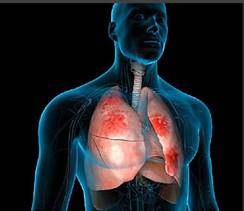
МЕТОДОЛОГИЧЕСКАЯ РАЗРАБОТКА ПО АНГЛИЙСКОМУ ЯЗЫКУ
ПО ТЕМЕ «PNEUMONIA»
Warm-up
· What respiratory system diseases do you know?
· How can you “catch” them?
· Do you know anyone who had pneumonia? What were the symptoms?
Vocabulary
|
sacs |
мешочки |
germ |
микроб |
|
springy |
пружинистый |
mucus |
слизь |
|
inflate |
надувать |
cilia |
реснички |
|
chills |
озноб |
confusion |
спутанность |
Read the text
Pneumonia is inflammation in your lungs caused by an infection.
You have two lungs, one on each side of your chest. Each lung has separate sections called lobes. Normally as you breathe air moves freely through your trachea or windpipe, then through large tubes called bronchi, through smaller tubes called bronchioles, and finally into tiny sacs called alveoli. Your airways and alveoli are flexible and springy. When you breathe in each air sac inflates like a small balloon and when you exhale the sacs deflate. Small blood vessels called capillaries surround your alveoli. Oxygen from the air you breathe passes into your capillaries, and then carbon dioxide from your body passes out of your capillaries into your alveoli so that your lungs can get rid of it when you exhale.
 If you have pneumonia your airways or lungs have an
infection caused by germs such as bacteria, viruses, fungi or parasites. Your airwaves
catch most germs in the mucus that lines your trachea, bronchi and bronchioles.
Hair like cilia lining the tubes constantly pushes the mucus and germs out of
your airways, where you may expel them by coughing. Sometimes germs make it
past your mucus and cilia and enter your alveoli. Normally cells of your immune
system attack these germs, which keep them from making you sick.
If you have pneumonia your airways or lungs have an
infection caused by germs such as bacteria, viruses, fungi or parasites. Your airwaves
catch most germs in the mucus that lines your trachea, bronchi and bronchioles.
Hair like cilia lining the tubes constantly pushes the mucus and germs out of
your airways, where you may expel them by coughing. Sometimes germs make it
past your mucus and cilia and enter your alveoli. Normally cells of your immune
system attack these germs, which keep them from making you sick.
However, if your immune system is weakened due to age, illness or fatigue, pneumonia causing germs can overwhelm your immune cells and begin to multiply. Your bronchioles and alveoli become inflamed as your immune system attacks the multiplying germs. The inflammation causes your alveoli to fill with fluid making it difficult for your body to get the oxygen it needs. If you have low burn pneumonia one lobe of your lungs is affected. If you have bronchopneumonia many areas of both lungs are affected.
Pneumonia may cause the following symptoms: difficulty breathing, chest pain, coughing, fever and chills, confusion, headache pain and fatigue. Pneumonia can lead to serious complications. Respiratory failure occurs when your breathing becomes so difficult that you need a machine called a ventilator to help you breathe. Bacteremia occurs when the bacteria causing your pneumonia move into your bloodstream where they may travel to infect other organs. In some cases of pneumonia a large collection of fluid and pus called an abscess may form inside one of your lungs. If an abscess forms around the outside of your lung it's called an empyema.
Possible treatments for pneumonia include:
· antibiotics if the cause is bacterial or a parasite,
· antiviral drugs if the cause is a flu virus,
· antifungal medication if the cause is a fungus,
· rest and drinking plenty of fluids
· over the counter (OTC) remedies to manage your fever, aches and pains.
If you have severe pneumonia you may be admitted to the hospital and given intravenous antibiotics and oxygen.
URL: https://youtu.be/fvTgruikHSM
Answer the questions
1. What is pneumonia?
2. What does the respiratory system consist of?
3. What happens when we breathe?
4. What do your airways or lungs have when you have pneumonia?
5. How do germs enter your alveoli?
6. What cells keep us from making sick?
7. Why is it difficult for your body to get the oxygen it needs when you have the inflammation in bronchioles and alveoli?
8. What are the symptoms of pneumonia?
9. What are possible treatments for pneumonia?
10. What to do if you have severe pneumonia?
Follow-up
· What tests can a person expect if it is pneumonia? (You need a chest x-ray to confirm you have pneumonia. You can expect lab tests such as blood cultures. You will also be asked to cough deeply and spit any mucous into a sterile cup. These tests help the doctor to choose the best treatment options for you.)
· Скачано с www.znanio.ru
Материалы на данной страницы взяты из открытых источников либо размещены пользователем в соответствии с договором-офертой сайта. Вы можете сообщить о нарушении.